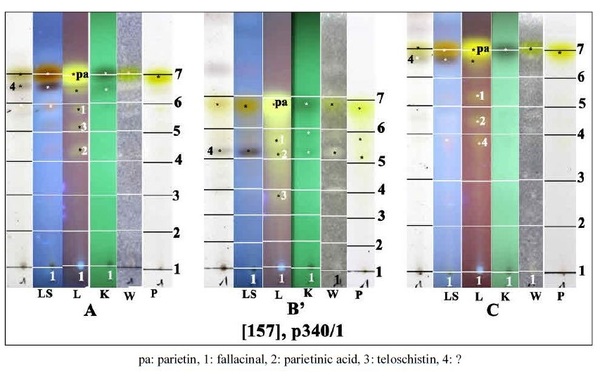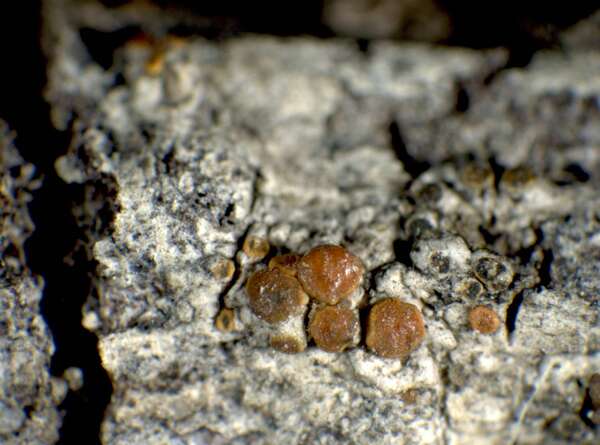Blastenia hungarica (H. Magn.) Arup, Søchting & Frödén
Nord. J. Bot., 31: 68, 2013. Basionym: Caloplaca hungarica H. Magn. - Göteb. K. Vetensk. Vitterh. Samh. Handl., ser. B, 6, 1: 28, 1944.
Synonyms: Caloplaca depauperata H. Magn. non (Müll. Arg.) Zahlbr.; Caloplaca ferruginea var. hungarica (H. Magn.) Clauzade & Cl. Roux
Distribution: N - Frl (TSB 3596), Ven (vidi!), TAA (Hinteregger 1994, Nascimbene & al. 2007b), Lomb, Piem (Matteucci & al. 2013), VA (Matteucci & Vanacore Falco 2015), Lig (TSB 33061). C - Tosc (SI 127), Abr (Vallese & al. 2022). S - Cal (CLU 18049).
Description: Thallus crustose, episubstratic, grey, rather thin (<100 μm thick) forming up to 1 cm wide patches. Apothecia biatorine, orange-brown to rusty orange, sessile, 0.3-0.6(-0.8) mm across, with a usually flat disc and a smooth, non-flexuose, somewhat paler, thin proper margin (thalline margin always absent). Proper exciple prosoplectenchymatous, orange in outer part, colourless within, amyloid, K+ red, C-; epithecium orange-brown, K+ red, C-; hymenium colourless, not inspersed with oil droplets, amyloid; paraphyses sparingly branched in upper part, 1.5-2 μm thick at base, the apical cells only slightly swollen; hypothecium colourless to pale yellowish brown. Asci 8-spored, clavate, functionally unitunicate, apically thickened with a broad internal beak, the inner part of apex and external cap I+ blue, Teloschistes-type. Ascospores 2-celled, polarilocular, hyaline, ellipsoid, (11.5-)12-14(-16) x (4-)5-6(-8) μm, the equatorial thickening (“septum”) 4-6 µm. Pycnidia uncommon, dark grey, with the Cinereorufa-green pigment. Conidia bacilliform, rarely narrowly ellipsoid, 3-5 x 1-1.5 μm. Spot tests: thallus K-, C-, KC-, P-; apothecia K+ red, C-. Chemistry: non-chlorinated anthraquinones in apothecia (chlorinated anthraquinones absent); thallus without anthraquinones; Cinereorufa-green pigment usually hardly detectable, but present around pycnidial ostioles and sometimes in injured apothecia. Note: a temperate to boreal-montane lichen found on twigs of acid-barked trees. According to Vondrák & al. (2020), morphologically identical populations growing in Mediterranean habitats at low altitudes belong to B. xerothermica, which has a strictly Mediterranean distribution and is quite common in Italy. Several earlier records of B. hungarica from lowland areas of Liguria and Central-Southern Italy (see Nimis 2016) have been attributed here to B. xerothermica.
Growth form: Crustose
Substrata: bark
Photobiont: green algae other than Trentepohlia
Reproductive strategy: mainly sexual
Commonnes-rarity: (info)
Alpine belt: absent
Subalpine belt: rare
Oromediterranean belt: absent
Montane belt: rare
Submediterranean belt: very rare
Padanian area: absent
Humid submediterranean belt: extremely rare
Humid mediterranean belt: absent
Dry mediterranean belt: absent
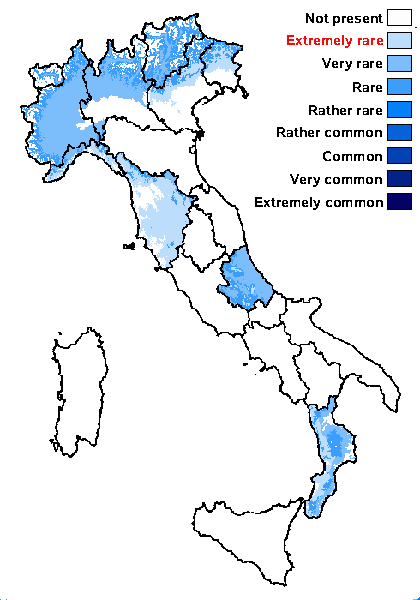
Predictive model
Herbarium samples
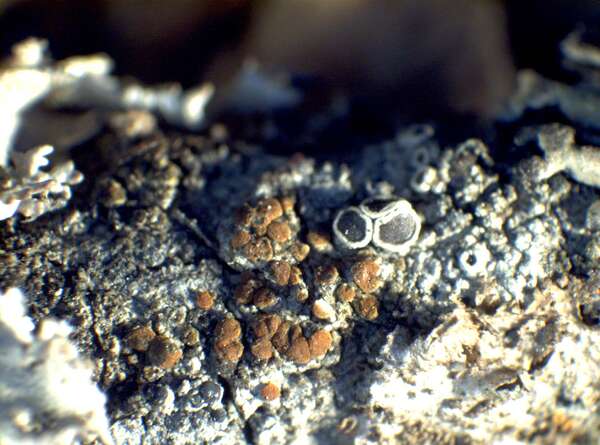

P.L. Nimis; Owner: Department of Life Sciences, University of Trieste
Herbarium: TSB (3596)
2001/11/13
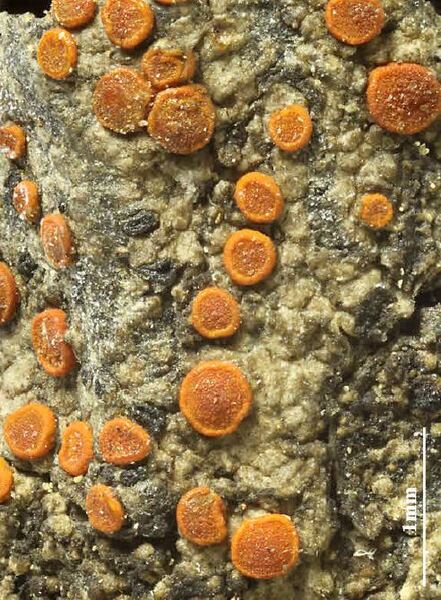

Felix Schumm – CC BY-SA 4.0
[157], Liechtenstein, Malbun, an Bergkiefer. Leg. F. Schumm 03.1967, det. J.Poelt
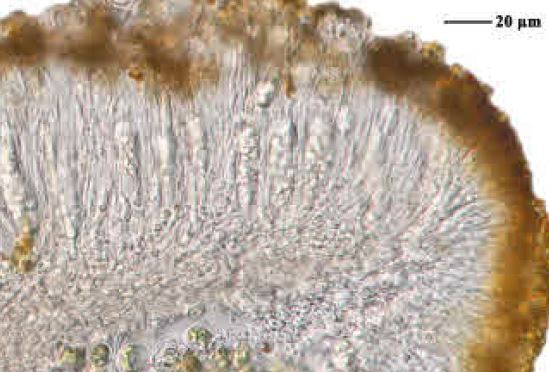

Felix Schumm – CC BY-SA 4.0
[157], Liechtenstein, Malbun, an Bergkiefer. Leg. F. Schumm 03.1967, det. J.Poelt


Felix Schumm – CC BY-SA 4.0
[157], Liechtenstein, Malbun, an Bergkiefer. Leg. F. Schumm 03.1967, det. J.Poelt


Felix Schumm – CC BY-SA 4.0
[157], Liechtenstein, Malbun, an Bergkiefer. Leg. F. Schumm 03.1967, det. J.Poelt


Felix Schumm – CC BY-SA 4.0
[157], Liechtenstein, Malbun, an Bergkiefer. Leg. F. Schumm 03.1967, det. J.Poelt
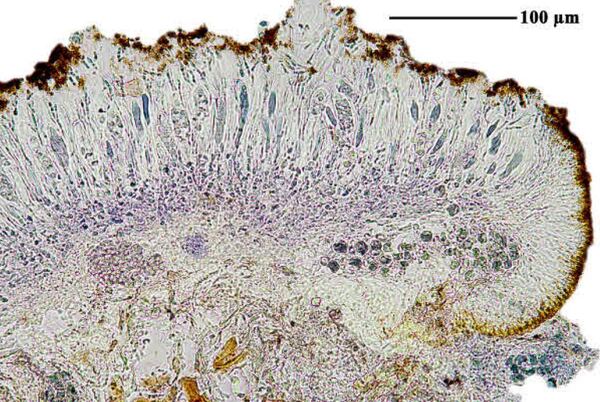

Felix Schumm – CC BY-SA 4.0
[157], Liechtenstein, Malbun, an Bergkiefer. Leg. F. Schumm 03.1967, det. J.Poelt
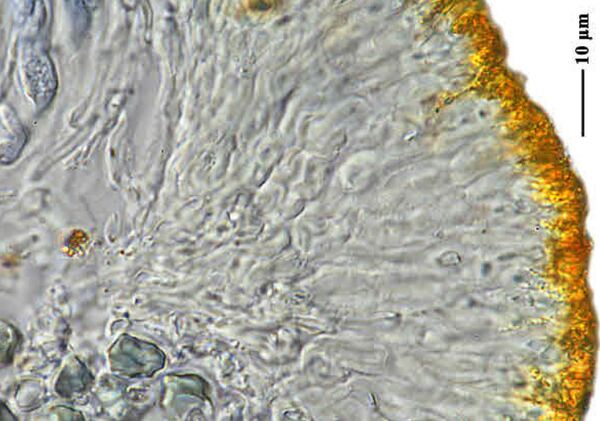

Felix Schumm – CC BY-SA 4.0
[157], Liechtenstein, Malbun, an Bergkiefer. Leg. F. Schumm 03.1967, det. J.Poelt
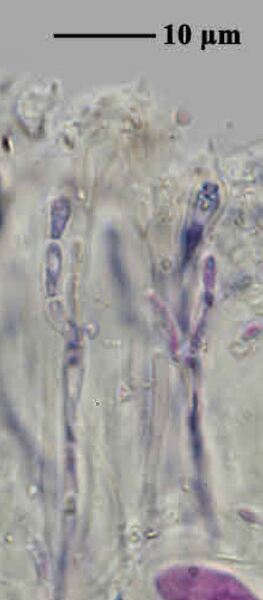

Felix Schumm – CC BY-SA 4.0
[157], Liechtenstein, Malbun, an Bergkiefer. Leg. F. Schumm 03.1967, det. J.Poelt


Felix Schumm – CC BY-SA 4.0
[157], Liechtenstein, Malbun, an Bergkiefer. Leg. F. Schumm 03.1967, det. J.Poelt
Growth form: Crustose
Substrata: bark
Photobiont: green algae other than Trentepohlia
Reproductive strategy: mainly sexual
Commonnes-rarity: (info)
Alpine belt: absent
Subalpine belt: rare
Oromediterranean belt: absent
Montane belt: rare
Submediterranean belt: very rare
Padanian area: absent
Humid submediterranean belt: extremely rare
Humid mediterranean belt: absent
Dry mediterranean belt: absent

Predictive model
| Herbarium samples |


P.L. Nimis; Owner: Department of Life Sciences, University of Trieste
Herbarium: TSB (3596)
2001/11/13


Felix Schumm – CC BY-SA 4.0
[157], Liechtenstein, Malbun, an Bergkiefer. Leg. F. Schumm 03.1967, det. J.Poelt


Felix Schumm – CC BY-SA 4.0
[157], Liechtenstein, Malbun, an Bergkiefer. Leg. F. Schumm 03.1967, det. J.Poelt


Felix Schumm – CC BY-SA 4.0
[157], Liechtenstein, Malbun, an Bergkiefer. Leg. F. Schumm 03.1967, det. J.Poelt


Felix Schumm – CC BY-SA 4.0
[157], Liechtenstein, Malbun, an Bergkiefer. Leg. F. Schumm 03.1967, det. J.Poelt


Felix Schumm – CC BY-SA 4.0
[157], Liechtenstein, Malbun, an Bergkiefer. Leg. F. Schumm 03.1967, det. J.Poelt


Felix Schumm – CC BY-SA 4.0
[157], Liechtenstein, Malbun, an Bergkiefer. Leg. F. Schumm 03.1967, det. J.Poelt


Felix Schumm – CC BY-SA 4.0
[157], Liechtenstein, Malbun, an Bergkiefer. Leg. F. Schumm 03.1967, det. J.Poelt


Felix Schumm – CC BY-SA 4.0
[157], Liechtenstein, Malbun, an Bergkiefer. Leg. F. Schumm 03.1967, det. J.Poelt


 INDEX FUNGORUM
INDEX FUNGORUM
 GBIF
GBIF
 DOLICHENS
DOLICHENS

